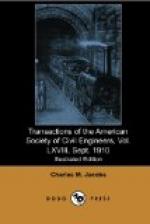Ninth Avenue Tunnels.—The two double-track tunnels under Ninth Avenue, constructed to obtain 100 ft. of additional tail room on each of four tracks, required an excavation 76 ft. wide, Fig. 12. The rock, although fair, was not firm enough for so great a span, and, to obviate the necessity of timbering, the center wall was built before excavating for the full width. The dip of the rock at this point is almost 90 deg., and to prevent blowing away the entire face in excavating for the tunnel, the pit excavation was not carried west to the final face below the springing line, a 10-ft. bench being left at that elevation. A top heading 9 ft. high and 10 ft. wide was started above that bench and, after penetrating about 10 ft., was widened to 20 ft. A cross-heading was driven in each direction at the west end of the first heading; the bench was then shot down, and the first 10 ft. of the longitudinal heading was widened sufficiently to receive the center wall, Fig. 12. After the middle wall had been concreted, any voids between its top and the rock were grouted through pipes left for that purpose; the wall was then protected by curtains of heavy round timber securely wired together, and the remainder of the excavation was made by widening the cross-headings toward the face. The muck was carried out by two cableways, one on each side of the completed middle wall, each of which was supported by a tower outside of the tunnel and a large hook-bolt grouted into the rock at the inner end of the tunnel. Forms were built for each tunnel complete, and the concrete was delivered by a belt conveyor, running over the top of the lagging, and moved out as the tunnel was keyed.
[Illustration: Fig. 12. TERMINAL STATION SKETCH SHOWING TWO TRACK TUNNELS AT NINTH AVENUE AND THIRTY-THIRD STREET]
FOOTNOTES
[1: Presented at the meeting of May 4th, 1910.]
[2: Reproduced as Plate IX in the paper by Mr. Noble.]
[Text reference for footnote 2: “one arm of the creek shown on General Viele’s map of 1865” The article is ASCE 1152, The East River Division, available from Project Gutenberg as e-text 18065]
* * * * * * * * * * * * * *
[Errata:
Table 2a
| 87 {166 + 64.6} | | | | | | |
| {166 + 75.6} | 23.44 | 1.00 | 0.34 | 2.25 | 0.42 | ... |
"2.25” is unclear; only “.25” is fully legible]



